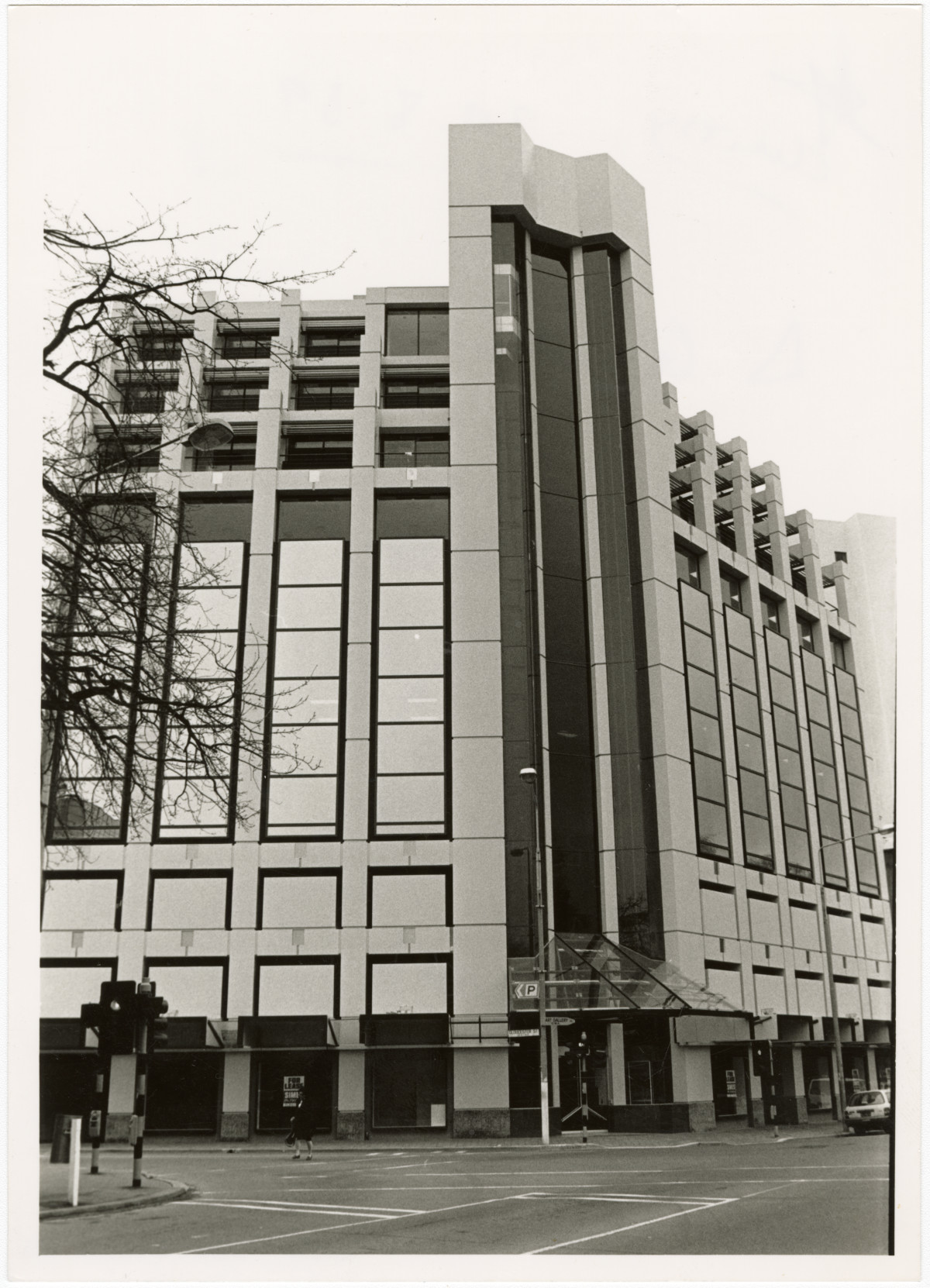The third in a series of posts uncovering the history of the city block that the new Christchurch convention centre, Te Pae is being built on.
The first building on town sections 715 & 716, the south-west corner of Gloucester Street and Oxford Terrace, was Samuel Gibb's store.
A bread and biscuit maker to trade Mr Gibb arrived in Otago possibly on the Victory in 1848. Gibb opened his store in March 1851 but spent a relatively short time in Christchurch before scaling the dizzy heights to become mayor of Oamaru not once but twice. Gibb's store sold a variety of essential provisions including maize, tea, hops, pork, raspberry vinegar, windows, coils of iron wire, soap, soda and Sydney candles, basically anything he could get his hands on! In 1854 William Hutchinson boot and shoemaker took over the store and later J. Moore, also a bootmaker, traded there. Near neighbours were A. Matthews, general grocer, and later Thomas Raine, manufacturer of lemonade, soda-water and ginger beer.
Hiddlestone & Sons basketmakers
John Hiddlestone, originally from South Shields in England arrived in Christchurch via Tasmania in 1863. A Wesleyan preacher, he was also a builder before setting up a basket making business on the corner of Gloucester Street and Oxford Terrace, later 86 Gloucester Street, in about 1868. The Hiddlestone family lived and worked on Gloucester street until John's sudden death in December 1892. In 1899 the land was transferred to Henry Tuck, a storekeeper trading on Colombo Street, who possibly used the now very old shop for storage or a bakehouse.
The building was sold for removal in February 1908 for the princely sum of £17. A Press article described it as "one of the oldest, if not the oldest buildings in Christchurch". This article linked Hiddlestone's basket shop and Samuel Gibb's original provision store as one and the same building which is highly plausible although contemporary photographs do create some room for doubt. (Maling & Co also later laid claim to Hiddlestone's picturesque wee shack in their advertising material)
With the site now clear Collins and Harman, architects of Gloucester Street, were able to put the construction of a new brick and stone building out for tender. Collins and Harman was one of the earliest architectural firms in New Zealand and most notably designed The Christchurch Press building.
Maling & Co Building 1908-1986
The new building opened in October 1908 as the offices and warehouse of Maling & Co. Maling & Co started first as a general importer in 1873, later the business specialised in imported wines, spirits and tea. Maling & Co had previously operated from premises on Hereford and then later Worcester Street before purpose building their new fancy store.
The building underwent substantial alterations in 1924 including connecting the existing building with a one next door, extending the cellars, installing a first floor tea testing room and goods lift with ready access to the tea blending machinery.
Maling & Co also imported cigarettes and tobacco, in 1925 a representative of the company waxed lyrical on the "soothing effects of pipe or cigarettes" and in 1931 Maling & Co forwarded a donation of five hundred guineas from the De Reszke Cigarette Company to the Hawke's Bay Earthquake Relief Fund.
In 1969 Maling & Co's Gloucester Street showroom had a make-over described thus "highly polished, bright and airy...a room which is alive with interesting textures and shapes", shaped like a barrel, the Warren & Mahoney designed space allowed "well-labeled classifications" of the different wines, spirits etc. into country of origin and price thus avoiding, the Press advertorial said, the embarrassment of mispronouncing strange-sounding foreign names or buying a wine outside your budget. With its varnished wood, end walls in blue hessian, architecturally designed furniture and fittings and tasting bar, this carpeted late 60s cellar was hip to-the-max. Some of the wines stocked included Bilbainas "white and red wine from sunny Spain", South Australian Stonyfell, Mcwilliam's Cresta Dore and Antonin Rodet's "light-hearted French white wines". Sweet, sugary 60s goodness.
Malings celebrated "A century of service" in 1973 with a multi-page Press advertorial and promises of "Friendly Personal Service", "Free City Delivery" and that "Life is more pleasant with WINE!" but sadly their boozy days were numbered.
In 1986 Maling & Co announced it would cease trading from the Gloucester Street site in May citing changes in the liquor industry, Sam Maling said "the site was no longer suitable as a drive-in...and the industry had changed to become a marginal business requiring large quantities to be stored and sold". The chummy days of old style liquor sales and sampling were over, "stack 'em high, sell 'em low" was the new mantra.
Maling & Co manager Dave Hughes drank a last drop of fine malt whiskey later that month to mark the last day of business after 113 years of trading.
Maling & Co were gone but not forgotten. The company name was purchased by a group of five Canterbury hotelier. The Maling's site on Gloucester Street, now owned by Meadow Mushrooms, was demolished in 1987 and Meadow Mushrooms chairman Phillip Burdon promised a "major development" of the site.
DFC House and Brannigans
The major development turned out to be the concrete and glass DFC House (Development Finance Corporation) designed by Warren and Mahoney. With a "sculpted appearance" the 10 floors were serviced by 3 high-speed lifts and tenants over the years included Sala Sala Sushi Bar, Cardinal Network and Pedersen & Partners.

The building was later renamed Brannigans and most notably housed The Bard on Avon "Ye Olde English Pub". This pub became the favoured haunt of librarians, within easy staggering distance of the Central Library on Gloucester Street, and while the beer, decor and music were decidedly average, the chips and gravy were delicious.
This building was demolished following the February 2011 Christchurch earthquake.








Add a comment to: Goodbye Gloucester Street West: Malings & Co